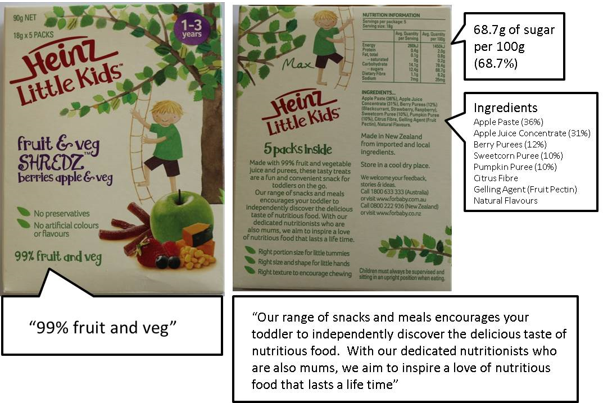‘Sugar-coating’ health claims in advertising
The Australian Competition and Consumer Commission (ACCC) is sending a warning to food companies to make honest and truthful claims on food packaging in its Federal Court case against H.J. Heinz Company Australia Ltd (Heinz).
Background
In June 2016, the ACCC commenced proceedings against Heinz, alleging that it made false and misleading representations and engaged in misleading conduct in relation to its ‘Little Kids Shredz’ products (Shredz).
Shredz has now been discontinued but was targeted at children aged 1-3 and its packaging featured prominent images of fresh fruit and vegetables with claims it contained “99% fruit and vegetables”. This claim can be construed to be accurate when examining the nutritional information, however, the nutritional information also reveals that the addition of apple juice concentrate (although naturally occurring) increases the product’s overall sugar content to 68.7%.

Image from ACCC
https://www.accc.gov.au/media-release/accc-takes-action-against-heinz-over-nutritional-claims-on-food-for-1-3-year-olds
The ACCC’s concern is clear: the combined effect or consumer “Take Out” of the images and statements suggests to consumers that the product is “of equivalent nutritional value to fruit and vegetables” and is a “healthy and nutritious food for children.” In the ACCC’s view this is not the case, with expert nutritionists and dietitians supporting their view in trial.
With enforcement action initiated by the ACCC against Unilever Australia Limited and The Smith’s Snackfood Company in relation to claims about School Canteen Guidelines, it is clear that the ACCC is taking focus on not only health claims on food packaging, but also how products are being marketed to children.
Lessons for brands
The matter was referred to mediation in early September this year, however, it remains unresolved (see https://www.comcourts.gov.au/file/Federal/P/SAD181/2016/actions). Ultimately, this case serves as a reminder to advertisers and brands to consider the overall and dominant impression that marketing material and packaging has on consumers. Claims which are “technically” accurate may be misleading depending on the context and medium in which they are used.
